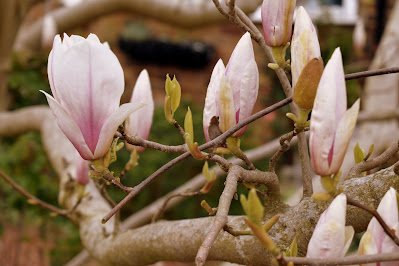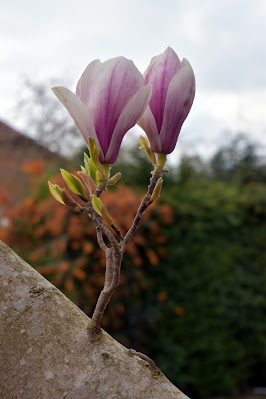When we moved here many years ago we inherited a gorgeous Magnolia tree. If you have a garden and suitable conditions I would recommend growing a Magnolia.
There are many types from small trees to very large trees. Colours are so beautiful and range from a shell-like pink, dark pink, yellow, purple, red and white. If I could I would have one of each.
The Beauty Of A Magnolia
It is true that the flowers only last a few weeks or just over a month in Spring but they are so worth waiting for each year and for me signal that Spring is truly here and the poor weather is mostly behind us. It is a sign of hope, of joy and more than once has made my heart full of happiness.
Nothing lifts my spirits quite like looking out of the window on a spring morning to see our beautiful Magnolia in full bloom its delicate yet robust flowers carried proudly on bare stems.
Magnolia generally flower on bare stems so you just see the beautiful flowers carried on bare branches. As the flowers fade the leaves come in, gorgeous soft green leaves that last all summer and well into autumn.
Winter gives us the bare branches that have their own architectural splendor especially when snow or frost lies on the branches. We drape the bare branches in festive lights which look very pretty.
Magnolias are fascinating. They are an ancient tree primarily pollinated by beetles. Flying insects and bees may well visit now to take advantage of any pollen, but they are not what Magnolia originally sought to attract.
However, do not worry you will not be overrun with beetles as you really do not often even see them.
Magnolias come in a wide variety of sizes and colours. They usually carry gorgeous tulip shaped flowers or in the case of Stellata, a star shaped flower.
Most are deciduous but there are a few that are evergreen though these will usually require a more sheltered place. If you want fragrance then there are Magnolias with scent.
Magnolias can grow to be very large but we can also buy smaller varieties more suitable for smaller town gardens. It is really a case of checking the full grown size of the tree.
This is not however a quick growing plant. We will need to have patience for it to grow over ten or even twenty years. However, it is still so very beautiful in its younger years, it is always worth introducing a Magnolia into a garden.
I know we will be leaving this house and garden in the next few years so I have bought two smaller magnolia varieties which I am growing on in pots that will be ready to plant out in our new garden once we move.
It may be that we do not get to see them full-grown but they will bring us so much pleasure as they grow from beautiful delicate buds to full gorgeous blooms with lovely green leaves.
Magnolia Soil Conditions And Watering
Magnolias love neutral to slightly acidic soil which is free draining. Our soil is slightly acidic but is heavy clay and our magnolia has grown very well. This is perhaps as our soil is very fertile which is also something Magnolias love.
However, not everyone will have acidic soil so if you have alkaline soil and want to grow a Magnolia you are best to buy Magnolia Grandiflora or Magnolia Delavayi.
It is best to plant your Magnolia in a sunny spot. If it is sheltered as well that is a bonus as the flowers won't be blown off so much by the wind or so damaged by frost.
A good rule of thumb is that the colder the area you live in choose a later flowering variety. That way you will be less troubled by frost and cold winds damaging the flowers or tree. Good varieties for cold areas are Magnolia Apollo or Magnolia Caerhays Surprise.
A grown magnolia takes care of itself with regards to water, in fact, you can do more harm than good watering it once it is well established. Naturally, its roots will go down to seek water so best to leave it alone. The last thing you want is for the roots to grow upwards seeking the water you are providing.
However, in its first year it will need good deep watering and maybe also in its second year, you can give it deep drinks of water. It is always a good idea to mulch around a Magnolia of any age each year with bark.
Pruning A Magnolia
This plant has specific pruning needs but do not be worried by this. If you have planted it in an appropriate area for its size pruning will be minimal.
Each year after flowering check it over for any broken or crossing branches and prune those out completely.
Be careful not to prune too much as Magnolias can become stressed and cease to flower. A good rule is no more than a third of the plant is pruned each year.
Sadly our naturally huge magnolia was planted by previous occupants really too close to the house so we have to prune it rather more than I would like to keep it smaller than its natural size.
We are careful though to prune only up to a third each year and over the last 20 years have left at least one year in every 3 where we do not prune anything except broken or crossing branches.
A smaller magnolia or one that has more space to grow naturally may well only need pruning once every few years.
If you have a Magnolia only ever prune it after it has finished flowering and the green leaves are growing in. Mid-summer is a perfect time. If you prune in the autumn you will cut off many of the flower buds.
Planting A New Magnolia.
it is a good idea to buy your Magnolia as a mature plant as you can afford. It will establish itself much better. However not too large a plant that it is difficult to plant easily. Also do your research as to variety, so that you know the fully grown tree will fit comfortably into the space available.
The roots of a Magnolia are surprisingly shallow so you don't need to dig a really deep hole. Do however make it wide enough so there is no competing grass around the plant.
The planting hole needs to be the same depth as the pot and we should be careful to treat it gently and not damage any roots. Firm in carefully and after watering deeply give it a good acidic mulch. Bark mulch is perfect for this purpose.
We give Magnolia the best chance if we plant it in Spring or late Autumn. Patience is a virtue though as a young newly planted magnolia may need a couple of years before it flowers well. However, I promise you it is well worth the wait.
Magnolia Flowers In The Home.
Each Spring I pick a few whole blooms or take the fallen petals and place them in a large bowl of water. This makes a pretty display. The petals are quite thick and sturdy so are easy to handle and float in the water. sometimes I also place whole flowers in the water to float which is a beautiful display.
Simply replace the petals every few days or if they start to go brown to keep the display fresh.
It really is a gorgeous way of having Magnolia flowers inside our homes to enjoy all day and evening.
Spring really is showtime for the Magnolia but it is a beautiful and majestic tree all year round.
I absolutely love Magnolias, they always lift my spirits after winter and I look forward to seeing their beautiful and exquisite flowers each and every year.



































